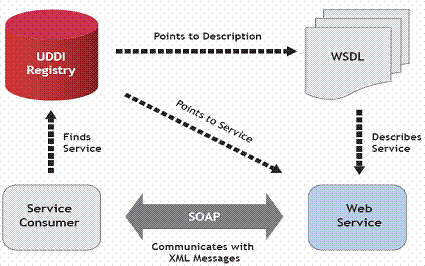Web Services Technologies
Web Services can be developed using any programming language and can be deployed on any platform. Web Services can communicate because they all speak the same language: the Extensible Markup Language (XML). Web Services use XML to describe their interfaces and to encode their messages. XML-based Web Services communicate over standard Web protocols using XML interfaces and XML messages, which any application can interpret.
But XML by itself does not ensure effortless communication. The applications need standard formats and protocols that allow them to properly interpret the XML. Hence three XML-based technologies are emerging as the de facto standards for Web Services:
• Simple Object Access Protocol (SOAP) defines a standard communications protocol for Web Services.
• Web Services Description Language (WSDL) defines a standard mechanism to describe a Web Service.
• Universal Description, Discovery and Integration (UDDI) provides a standard mechanism to register and discover Web Services.
Figure 2.2 shows how these technologies relate to one another. When a service provider wants to make the service available to service consumers, he describes the service using WSDL and registers the service in a UDDI registry. The UDDI registry will then maintain pointers to the WSDL description and to the service. When a service consumer wants to use a service, he queries the UDDI registry to find a service that matches his needs and obtains the WSDL description of the service, as well as the access point of the service. The service consumer uses the WSDL description to construct a SOAP message with which to communicate with the service.

Figure 2.2 Web Services Technologies
Next >> XML |